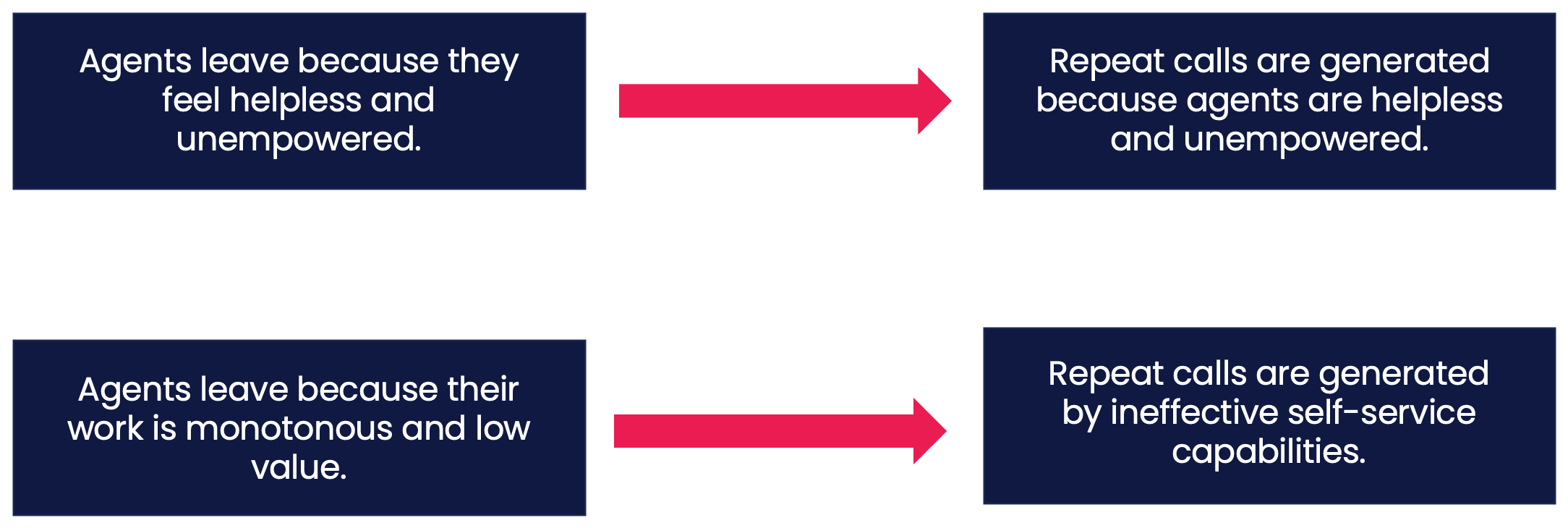There’s a correlation between Repeat Calls and Agent Attrition – Here’s how to solve both
(6 min read)
We recently co-hosted a webinar with Zoom, in which we discussed the perceived juxtaposition of the human touch versus AI in the contact centre environment. Whilst preparing for my talk track I discovered an interesting correlation between the reasons for repeat calls, and the reasons for agent attrition – two of the biggest challenges faced by contact centre/customer service teams.
The fact that there’s a correlation could be a good thing, or, on the other hand, it could be a bad thing. A good thing because solving one potentially helps to solve the other. Or a bad thing because the fact these problems persist suggest they may be the most difficult to solve of all.
In this article we dig into the reasons and causes of repeat calls and agent attrition, and explain how businesses can make significant inroads into reducing the cost, efficiency, and CX impact of these perennial challenges.
Repeat Calls
In 2023, 20% of inbound customer service calls were repeats, costing contact centres £6.7bn per year (source: Gartner).
Repeat calls are a persistent problem for customer contact teams, and they happen when customer support enquiries are not resolved the first time they get in touch. Generally, when customers call customer service, they are looking for an answer to a question, or solution to a problem. They need somebody to resolve their issue and do not want to call back for the same problem. Not only are repeat calls an expensive problem for businesses, but they also imply that customers are unhappy with the service provided, because it took more effort than it should have done to receive the help they needed.
So, that’s one of the main reasons for repeat calls, but it isn’t the root cause. The root cause is in fact operational, and it stems from having ill-equipped agents, and disjointed CX processes. According to a recent ContactBabel study, the operational causes of repeat calls are as follows:
Unempowered & helpless agents
This happens when agents do not have the knowledge, access to the right information, or do not have the authority to suggest and process an adequate resolution for the customer.
Lack of information on the Agent Desktop
Agents are constantly chasing their tails, trying to source customer/case information from a plethora of systems, and unable to understand the context and history of an enquiry.
Ineffective or limited self-service capabilities
AI self-serve has been deployed but it isn’t effective in resolving customer queries. Or self-serve has not been deployed and the customer service agents are forced to deal directly with every single problem.
Lack of proactive communication when issues arise
A large proportion of customer contact could be avoided simply by adopting a proactive approach. If something goes wrong, tell the customer (don’t wait for them to tell you).
Agent Attrition
In 2023, contact centre agent attrition rates were estimated at 26%. And replacing an agent costs approximately 16% of their gross annual earnings. Attrition is another persistent problem for customer contact teams. In a mid-sized contact centre (500 seats) that 16% equates to upwards of £275k just in replacement costs every year!
Some of this staff turnover is probably unavoidable, as the service agent role is more likely to attract people in transitory periods of their lives – for example when studying, just starting out, or a new parent. But some of the churn could be avoided by creating a better employee experience, where friction is minimised, the work is meaningful, and potential career paths are more visible.
According to Gartner, the main reasons agents leave are:
Inadequate training
Often exacerbated by poorly integrated technology, inadequate training is one of the top reasons for attrition, as cited by contact centre agents.
Micromanagement
By its very nature the contact centre is a KPI-driven environment, often high pressure, and can be pretty relentless. Add in a big wallboard with visual red flags against individual performance metrics and you can see why some agents feel they are being micromanaged. Some of the issue here is also likely linked to inadequate training– if agents aren’t properly trained, they will not feel empowered. And micromanaged is basically the opposite of empowered.
Low wages
Whilst over $800bn per year is spent by brands on advertising, it’s often the case that as little as possible is spent by companies on customer service. Fundamentally this is because marketing is considered an investment, whilst customer service is considered a cost. But, for us, this doesn’t make sense. Customer service can be a profit exercise because effortless customer experience delivers loyalty; and loyalty delivers retention, repeat business, and reputation/referral.
Limited or no career prospects
Traditionally, contact centres have been somewhat transient environments with little to no career progression. Forward-thinking employers have been doing more in recent years to improve the agent experience through modern technology and better process, but there remains a huge (relatively untapped) opportunity to home-grow future talent directly from your customer service team.
Did you spot the correlation?

In other words, this becomes a vicious circle that can be difficult to break.
So how do you solve it?
There isn’t a silver bullet; rather a combination of initiatives that will contribute towards solving the problem. But (and here’s the key insight) all of it starts and ends with the customer service agent. In other words, if you work on getting the agent experience right, the right customer experience follows.
Considering the correlation described above, there are two key areas for contact centres to move the needle in 2024 in the pursuit of reducing agent attrition and repeat call volumes:
Agents are capable and feel empowered.
Generally speaking, knowledge is power. A confident and well-versed service agent will always be more capable, although this can be very difficult to achieve and sustain, particularly when you consider that the average tenure of a service agent is just over 12 months. Onboarding and training can be a constant cycle, and it sometimes feels like you’re just training up agents to leave. The answer therefore is to significantly reduce the length of time it takes to train and onboard service agents, so they reach optimal performance as quickly as possible.
This is where cloud contact centre and AI technology can bear fruit. If you are not presenting customer details, contact history, or case information to agents when contact arrives, there is a strong likelihood the call will last longer than it needs to, and a high chance the issue won’t be resolved at the first time of asking. Furthermore, real-time speech and text analytics provide the ability to digitally coach agents to the right resolution, and minimise their post-contact administration through summarisation, and process automation. With the right technology strategy in place, your agents will feel empowered to resolve customer contact quickly, efficiently, and at the first time of asking.
Putting it simply, your agent desktop needs to be easy to use, joined-up, integrated, and AI-enabled. This way, agents have the information and guidance they need at their fingertips, when they need it. If your agents are still operating across multiple browser tabs, with disconnected systems and processes, then this should be a key area of your CX technology focus and investment in 2024.
The work agents do is interesting and feels valuable.
Agents often complain that their work is monotonous and low value, and it’s not hard to see why they would say that. Dealing with the same or similar enquiries day in/day out doesn’t exactly make for an interesting or fulfilling career path. Whereas, dealing with more challenging queries feels intrinsically more rewarding and helps agents to see that there is a career path beyond the contact centre. And there is – whether it’s in sales, account management, brand development, customer success, IT support, journey design, credit control etc., your customer service agents are learning and practicing the skills that they can transfer to other departments in your business.
Businesses would do well to pave this career path for customer service agents. Why not see your agents as an opportunity to home-grow the talent that will staff your other departments for years to come? Not only will they understand your culture, values, proposition, and brand positioning better than most, it’s a huge cost and time-saver, and ultimately lower risk versus recruiting externally.
To enable this businesses need to consider where AI and self-service can assist and empower their customer service agents. AI is not a straight replacement for people, it’s supposed to make life easier for them. Whether that’s through the successful automation of high volume/low value contact intents, automating post-call administration tasks, or providing real-time information and guidance in the agent desktop to assist with contact resolution. By automating monotonous and high volume tasks, and assisting your customer service teams with real-time intelligence, agents have the opportunity to work on different, more challenging, more interesting, and ultimately more valuable customer queries.
About Acceleraate
We are CX solution and development specialists with a 20-year track record of transforming customer contact through CX consulting, solution design, implementation, integration, and technology development. No matter how sticky your challenge we provide smart people and technology to deliver the right solution faster.
We transform customer contact with smart people and technology
About the author

Part of Founded Group Limited








